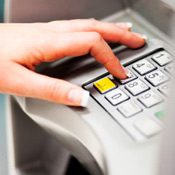How Blockchain Can Transform ATM Security And Make It More Reliable
Blockchain technology has the potential to enhance ATM security in several ways. By leveraging the unique features of blockchain, such as decentralization, immutability, and transparency, the following applications can strengthen ATM security:
1. Secure Identity Management: Blockchain can provide a robust and decentralized identity management system for ATM users. Instead of relying on traditional authentication methods like passwords or PINs, blockchain-based identity solutions can use cryptographic keys and digital signatures to verify user identities. This reduces the risk of identity theft and unauthorized access to ATMs.
2. Transaction Verification and Integrity: Blockchain can ensure the integrity of ATM transactions by providing a transparent and tamper-proof record of all transaction data. Each transaction can be recorded as a block in the blockchain, making it difficult for attackers to modify or manipulate transaction details. Users can independently verify the transaction history, promoting trust and transparency.
3. Anti-Fraud Measures: Blockchain can help prevent ATM-related fraud, such as card skimming and counterfeit transactions. By storing card-related information, including card numbers and transaction details, on the blockchain, it becomes more challenging for criminals to tamper with or clone cards. Additionally, the decentralized nature of blockchain reduces the reliance on centralized databases, which are often vulnerable to hacking or data breaches.
4. Secure Transaction Settlement: Blockchain technology can facilitate secure and near-instantaneous settlement of ATM transactions. Traditional settlement processes involve multiple intermediaries, leading to delays, higher costs, and increased security risks. With blockchain, transactions can be settled directly between the involved parties, eliminating the need for intermediaries and reducing the chances of fraud or unauthorized access to transaction data.
5. Smart Contracts for ATM Operations: Smart contracts, which are self-executing agreements coded on the blockchain, can automate and secure various aspects of ATM operations. For example, smart contracts can define rules for ATM cash replenishment, ensuring that only authorized entities can refill cash and tracking the transaction history securely. This reduces the risk of insider attacks and improves overall ATM security.
6. Enhanced Auditability: Blockchain’s transparent nature enables enhanced auditability of ATM operations. Regulatory bodies and financial institutions can access the blockchain to monitor and verify ATM transactions, ensuring compliance with regulations and identifying any suspicious activities or patterns. This can help prevent money laundering, illicit transactions, and other financial crimes.
7. Shared Threat Intelligence: Blockchain networks can facilitate the sharing of threat intelligence among financial institutions, ATM operators, and security agencies. By securely exchanging information about emerging threats, attack patterns, and vulnerabilities, the industry as a whole can better protect against ATM-related cyber attacks. This collaborative approach can enhance the overall security posture and response capabilities.
While blockchain technology offers promising solutions for ATM security, its implementation should be approached with caution. Considerations such as scalability, performance, and privacy need to be addressed. Additionally, the integration of blockchain with existing ATM infrastructure and regulatory compliance should be carefully managed.
Also read: Intersection Of AI And Blockchain: The Potential To Revolutionize Various Industries
Current state of ATM security and the challenges that exist
The current state of ATM (Automated Teller Machine) security is a topic of concern due to the continuous evolution of sophisticated cyber threats and criminal activities. While significant efforts have been made to enhance ATM security, several challenges persist. Let’s explore the current state of ATM security and the challenges that exist:
1. Skimming: Skimming remains a prevalent ATM security threat. Criminals attach devices to ATMs, such as card readers and hidden cameras, to capture card data and PINs entered by users. This stolen information is then used to create counterfeit cards or conduct fraudulent transactions.
2. Card Trapping: Card trapping involves placing a device or a sticky material in the card slot to capture and retain the user’s card. Criminals retrieve the trapped cards later to clone them or use them for fraudulent purposes.
3. Cash Trapping: Cash trapping occurs when criminals place a device or obstruct the cash dispenser to prevent cash from being properly dispensed. The user assumes that the transaction failed, but the criminals later retrieve the trapped cash.
4. Malware and ATM Attacks: Sophisticated malware targeting ATMs has emerged, allowing criminals to compromise the ATM’s operating system or network connection. These malware attacks can enable unauthorized cash withdrawals, control the ATM remotely, or steal sensitive customer data.
5. Network and Data Breaches: ATMs are connected to banking networks, making them potential targets for network breaches. If attackers gain unauthorized access to the ATM network, they can manipulate transactions, steal customer data, or compromise the integrity of the system.
6. Insider Threats: Insider threats pose a significant challenge to ATM security. This involves individuals with authorized access to ATM systems, such as employees or contractors, misusing their privileges to commit fraudulent activities or leak sensitive information.
7. Physical Attacks: ATMs can be physically attacked using various techniques, such as ramming the machine with vehicles, using explosives, or attempting to break open the safe compartments to access cash directly. These attacks not only pose a security risk but also endanger public safety.
Addressing these challenges requires a multi-layered approach to ATM security:
a. Physical Security: Measures like surveillance cameras, tamper-evident seals, and secure ATM enclosures can deter physical attacks and tampering attempts. Regular maintenance and inspections are also crucial to identify and mitigate vulnerabilities.
b. Encryption and Authentication: Implementing strong encryption protocols and two-factor authentication can protect data transmission and ensure the integrity of ATM transactions. Secure key management systems and secure boot processes are essential to prevent unauthorized access and tampering.
c. Anti-Skimming and Anti-Trapping Technologies: Deploying advanced anti-skimming and anti-trapping technologies, such as card readers with anti-skimming mechanisms and sensors to detect obstructions, can mitigate skimming and trapping attacks.
d. Software Security: Regular software updates and patches should be applied to ATMs to address vulnerabilities and protect against malware attacks. Secure coding practices and secure software development lifecycles should be followed to minimize software-related security risks.
e. Network Security: Implementing firewalls, intrusion detection and prevention systems, and network segmentation can safeguard the ATM network from unauthorized access and data breaches. Strong authentication and encryption protocols should be used to secure network communications.
f. User Awareness and Education: Educating ATM users about potential risks, such as skimming and phishing, can help prevent successful attacks. Clear instructions and prompts on ATMs can also guide users to detect and avoid suspicious devices or activities.
g. Collaboration and Industry Standards: Collaboration among financial institutions, ATM manufacturers, and security experts is essential to share threat intelligence, develop best practices, and establish industry standards for ATM security.
While significant efforts have been made to improve ATM security, it remains an ongoing challenge due to the evolving tactics of cybercriminals. Continuous research, investment in security technologies, and proactive security measures are crucial to stay ahead of emerging threats and protect ATM users and financial systems.
How blockchain can be used to improve ATM security
Blockchain technology has the potential to significantly enhance ATM security in several ways, including increased transparency and traceability, reduced risk of fraud and counterfeiting, improved efficiency and speed of transactions, and enhanced customer experience. Let’s explore each of these aspects in detail:
1. Increased Transparency and Traceability: Blockchain provides a transparent and immutable ledger of all ATM transactions. Each transaction is recorded as a block on the blockchain, creating a permanent and auditable record. This transparency ensures that all transaction details are visible to authorized parties, reducing the risk of malicious activities. Any attempts to tamper with the transaction history would require consensus from the entire network, making it highly improbable. With increased transparency, regulators, financial institutions, and ATM operators can monitor transactions and detect any suspicious activities, enhancing the overall security of ATM operations.
2. Reduced Risk of Fraud and Counterfeiting: Blockchain technology can significantly reduce the risk of fraud and counterfeiting at ATMs. By storing card-related information, such as card numbers and account balances, on the blockchain, it becomes difficult for criminals to clone cards or manipulate transaction data. Additionally, blockchain-based identity management systems can authenticate users securely, reducing the risk of identity theft and unauthorized access. The decentralized nature of blockchain eliminates the need for centralized databases, which are often targeted by hackers. These measures collectively strengthen the security of ATM transactions and mitigate fraud risks.
3. Improved Efficiency and Speed of Transactions: Blockchain enables direct peer-to-peer transactions without the need for intermediaries, resulting in improved efficiency and faster settlement times. Traditional ATM transactions often involve multiple intermediaries, which can introduce delays and increase costs. By leveraging blockchain’s decentralized and distributed ledger, transactions can be settled directly between the ATM and the user’s account, reducing processing times and eliminating unnecessary complexities. This streamlined process enhances the efficiency and speed of ATM transactions, providing a seamless experience for users.
4. Enhanced Customer Experience: Blockchain technology can greatly enhance the customer experience at ATMs. By providing a secure and transparent transaction environment, users can have greater confidence in their interactions with ATMs. Blockchain-based identity management systems can simplify authentication processes, eliminating the need for passwords or PINs. Additionally, the elimination of intermediaries and faster settlement times result in quicker access to funds, reducing waiting times at ATMs. The enhanced security measures provided by blockchain create a sense of trust and reliability, fostering a positive customer experience.
Furthermore, blockchain-based smart contracts can automate various aspects of ATM operations, such as cash replenishment and maintenance schedules. This automation reduces manual intervention, minimizes errors, and ensures a smooth and uninterrupted ATM service. The use of blockchain technology also allows for cross-border transactions with greater ease and lower costs, providing convenience for travelers using ATMs in foreign countries.
In summary, blockchain technology offers significant improvements to ATM security by increasing transparency and traceability, reducing the risk of fraud and counterfeiting, improving transaction efficiency and speed, and enhancing the overall customer experience. By leveraging blockchain’s unique features, ATMs can become more secure, efficient, and user-friendly, providing a reliable and seamless banking experience for individuals and businesses alike.
Also read: Top 10 Blockchain Integrated Fintech Companies In 2023
Top 10 examples of Blockchain being used to improve ATM security
- Fraud prevention. Blockchain can help to prevent fraud by providing a secure and transparent way to track transactions. This is because all transactions on a blockchain are recorded in a permanent and immutable ledger. This makes it very difficult for fraudsters to make fraudulent transactions without being caught.
- Data security. Blockchain can also help to improve data security by providing a more secure way to store and share data. This is because blockchain is a distributed ledger, which means that data is stored on multiple computers across a network. This makes it very difficult for hackers to gain access to data stored on a blockchain.
- Customer authentication. Blockchain can also be used to improve customer authentication by providing a more secure way to verify customer identities. This is because blockchain can be used to create digital identities that are linked to a user’s biometric data. This makes it very difficult for someone to impersonate another user.
- Compliance. Blockchain can also help financial institutions to comply with regulations by providing a more secure and transparent way to track transactions. This is because all transactions on a blockchain are recorded in a permanent and immutable ledger. This makes it very easy for regulators to audit financial institutions and ensure that they are complying with regulations.
- Reduced costs. Blockchain can also help to reduce costs for financial institutions by streamlining operations and reducing the need for intermediaries. This is because blockchain can be used to automate many of the processes that are currently handled by intermediaries.
- Improved efficiency. Blockchain can also help to improve efficiency by reducing the time it takes to process transactions. This is because blockchain is a distributed ledger, which means that transactions can be processed in parallel across multiple computers.

- Increased transparency. Blockchain can also help to increase transparency by providing a more secure and transparent way to track transactions. This is because all transactions on a blockchain are recorded in a permanent and immutable ledger. This makes it very easy for users to see how their money is being used.

- Enhanced customer experience. Blockchain can also help to enhance the customer experience by providing a more secure, efficient, and transparent way to use ATMs. This can lead to increased customer satisfaction and loyalty.
- New opportunities. Blockchain is a rapidly evolving technology, and there are many new opportunities for its use in the ATM industry. For example, blockchain could be used to develop new types of ATMs that offer new features and services.
- Improved security. Overall, blockchain can help to improve ATM security in a number of ways. By providing a more secure and transparent way to track transactions, blockchain can help to prevent fraud, protect data, and improve customer authentication. Additionally, blockchain can help to reduce costs, improve efficiency, increase transparency, enhance the customer experience, and create new opportunities for the ATM industry.

These are just a few examples of how blockchain is being used to improve ATM security. As blockchain technology continues to evolve, we can expect to see even more innovative and secure applications of blockchain in the ATM industry.
Challenges and limitations of using blockchain for ATM security
While blockchain technology holds great promise for improving ATM security, it also faces several challenges and limitations that need to be addressed. Here are some key considerations:
1. Scalability: One of the primary challenges is the scalability of blockchain networks. Traditional blockchains, such as Bitcoin and Ethereum, have limitations in terms of transaction processing speed and capacity. ATMs handle a large volume of transactions, and blockchain may struggle to keep up with the scale and speed required for real-time ATM operations. Solutions like layer 2 protocols, sharding, or alternative consensus mechanisms need to be explored to address scalability concerns.
2. Performance and Latency: Blockchain transactions typically involve multiple validations by network nodes, which can introduce latency. ATM transactions require fast processing times to maintain a seamless user experience. Blockchain networks must ensure quick transaction confirmation and settlement to meet the performance expectations of ATMs.
3. Privacy and Compliance: Blockchain’s inherent transparency can conflict with privacy regulations and compliance requirements. ATM transactions involve sensitive financial data that should be protected and comply with data protection laws. Implementing privacy-enhancing techniques like zero-knowledge proofs or private/permissioned blockchain networks may be necessary to balance privacy requirements with the need for transparency and security.
4. Integration with Legacy Systems: Integrating blockchain solutions with existing ATM infrastructure can be complex. ATMs are often part of well-established banking networks and systems that may not be blockchain-compatible. Retrofitting legacy systems to incorporate blockchain technology may require substantial investment and careful planning to ensure compatibility, interoperability, and minimal disruption to existing operations.
5. User Experience: Blockchain technology, with its complex cryptographic processes and decentralized nature, may introduce challenges to the user experience at ATMs. Users are accustomed to a simple and efficient interface, and any disruptions or complexities in the transaction process may deter adoption. The user experience must be carefully designed to ensure a seamless and user-friendly interaction with blockchain-powered ATMs.
6. Energy Consumption: Many blockchain networks, especially those using Proof-of-Work consensus, are energy-intensive. ATM networks operating on blockchain technology would need to consider the environmental impact and sustainability aspects. Exploring alternative consensus mechanisms like Proof-of-Stake or energy-efficient protocols can help mitigate this challenge.
7. Regulatory Considerations: Blockchain technology is still in its early stages, and regulatory frameworks surrounding its implementation are evolving. The adoption of blockchain for ATM security would require alignment with existing regulatory requirements and compliance standards. Clear guidelines and regulations need to be established to ensure the legal and regulatory aspects of blockchain-powered ATMs.
8. Cost and Infrastructure: Implementing blockchain technology can involve significant costs, including network infrastructure, software development, security measures, and ongoing maintenance. Financial institutions and ATM operators need to evaluate the cost-benefit ratio of blockchain solutions and consider factors like Return on Investment (ROI) and long-term sustainability.
Addressing these challenges requires collaborative efforts between blockchain developers, financial institutions, ATM manufacturers, and regulatory bodies. Research and development in blockchain scalability, privacy-enhancing technologies, and user experience design are crucial for overcoming these limitations and realizing the potential benefits of blockchain for ATM security.
Overall, while blockchain offers exciting possibilities for enhancing ATM security, challenges related to scalability, performance, privacy, integration, user experience, energy consumption, regulations, and costs must be carefully addressed to ensure successful implementation. By actively working to overcome these limitations, blockchain technology can provide robust security measures and revolutionize the ATM industry.
Future of blockchain and ATM security
The future of blockchain and ATM security holds great potential for transforming the way ATMs operate and improving overall security measures. Here are some key aspects that illustrate the future prospects:
1. Enhanced Security: Blockchain technology provides a robust foundation for strengthening ATM security. As blockchain matures and evolves, more advanced cryptographic techniques, privacy-enhancing features, and consensus mechanisms will be developed, further enhancing the security of ATM transactions. The integration of technologies like zero-knowledge proofs and multi-factor authentication can provide additional layers of security, making it harder for attackers to compromise ATMs.
2. Decentralized ATM Networks: With blockchain, it becomes possible to create decentralized ATM networks that operate independently of centralized financial institutions. This can enable direct peer-to-peer transactions, reducing reliance on intermediaries and potential vulnerabilities associated with centralized systems. Decentralized ATM networks can enhance security by eliminating single points of failure and reducing the risk of network breaches or data manipulation.
3. Seamless Cross-Border Transactions: Blockchain technology has the potential to simplify and secure cross-border ATM transactions. By leveraging blockchain’s decentralized nature and smart contracts, international ATM transactions can be settled directly between the involved parties, eliminating the need for multiple intermediaries and reducing transaction costs. This can lead to faster, more efficient, and secure cross-border transactions for ATM users.
4. Integration with Internet of Things (IoT): The convergence of blockchain with IoT can revolutionize ATM security. IoT devices can be utilized to enhance physical security measures at ATMs, such as real-time monitoring, remote diagnostics, and predictive maintenance. Combining blockchain’s transparency and immutability with IoT’s data collection capabilities can provide a comprehensive security framework for ATMs.
5. Biometric Authentication: Blockchain can facilitate secure biometric authentication for ATM transactions. Biometric data, such as fingerprints or facial recognition, can be stored on the blockchain in a secure and tamper-proof manner. This enables users to authenticate themselves using biometric identifiers, reducing the reliance on vulnerable passwords or PINs. Biometric authentication combined with blockchain’s security features can significantly enhance the overall security of ATM transactions.
6. Improved Fraud Detection and Prevention: Blockchain’s transparency and real-time transaction tracking can enable advanced fraud detection and prevention mechanisms. By analyzing patterns and anomalies in the blockchain data, machine learning algorithms can identify potential fraudulent activities and trigger alerts for investigation. This proactive approach can help financial institutions and ATM operators prevent fraud and respond quickly to security breaches.
7. Interoperability and Standardization: The future of blockchain and ATM security relies on interoperability and standardization efforts. Collaboration among industry stakeholders is crucial to establish common standards, protocols, and interfaces for blockchain-based ATM systems. This ensures seamless integration, compatibility, and interoperability between different blockchain networks, financial institutions, and ATM operators.
8. Regulatory Frameworks and Compliance: As blockchain technology evolves, regulatory frameworks will adapt to address the unique aspects of blockchain-powered ATMs. Governments and regulatory bodies will work to establish clear guidelines and compliance standards to ensure legal and secure implementation of blockchain in the ATM industry. Compliance with Anti-Money Laundering (AML) and Know Your Customer (KYC) regulations will be crucial for blockchain-based ATM networks.
In conclusion, the future of blockchain and ATM security is promising. As blockchain technology continues to advance and mature, it has the potential to revolutionize ATM operations, enhance security measures, and provide a more seamless and secure banking experience for users. Collaboration among industry stakeholders, ongoing research, and technological advancements will be key to unlocking the full potential of blockchain for ATM security.
Stay informed with daily updates from Blockchain Magazine on Google News. Click here to follow us and mark as favorite: [Blockchain Magazine on Google News].
Get Blockchain Insights In Inbox
Stay ahead of the curve with expert analysis and market updates.
latest from tech
Disclaimer: Any post shared by a third-party agency are sponsored and Blockchain Magazine has no views on any such posts. The views and opinions expressed in this post are those of the clients and do not necessarily reflect the official policy or position of Blockchain Magazine. The information provided in this post is for informational purposes only and should not be considered as financial, investment, or professional advice. Blockchain Magazine does not endorse or promote any specific products, services, or companies mentioned in this posts. Readers are encouraged to conduct their own research and consult with a qualified professional before making any financial decisions. The featured image used is just a creative depiction of the title and it does not intend to hurt sentiments of any person or institution. If it hurts anyone sentiments, please do not hesitate to reach out to Blockchain Magazine.

 Bitcoin
Bitcoin  Ethereum
Ethereum  XRP
XRP  Tether
Tether  Solana
Solana  USDC
USDC  Dogecoin
Dogecoin  Cardano
Cardano  Lido Staked Ether
Lido Staked Ether  TRON
TRON  Wrapped Bitcoin
Wrapped Bitcoin  Chainlink
Chainlink  Wrapped stETH
Wrapped stETH  Sui
Sui  Avalanche
Avalanche  Stellar
Stellar  Hedera
Hedera  Toncoin
Toncoin  Shiba Inu
Shiba Inu  LEO Token
LEO Token  Hyperliquid
Hyperliquid  Bitget Token
Bitget Token  Litecoin
Litecoin  WETH
WETH  USDS
USDS  Polkadot
Polkadot  Bitcoin Cash
Bitcoin Cash  Ethena USDe
Ethena USDe  MANTRA
MANTRA  Wrapped eETH
Wrapped eETH  Uniswap
Uniswap  Pepe
Pepe  Ondo
Ondo  Monero
Monero  Aave
Aave  WhiteBIT Coin
WhiteBIT Coin  NEAR Protocol
NEAR Protocol  Mantle
Mantle  Official Trump
Official Trump  Aptos
Aptos  Dai
Dai  Internet Computer
Internet Computer  Ethereum Classic
Ethereum Classic  Bittensor
Bittensor  Cronos
Cronos  OKB
OKB  POL (ex-MATIC)
POL (ex-MATIC)  Gate
Gate 







